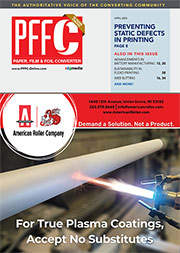Featured Stories
-
Preventing Static Defects in Digital Printing
Digital printing has revolutionized document creation. -
Choosing the Right Flexible Packaging Pouching Supplier
Wish you had more production capability to fulfill pouching jobs or maybe you are looking for a backup when your equipment goes down? -
Sun Chemical White Paper: Color Management
Ensuring Color Consistency in Every Corner of the Globe
News | New Products
-
Avery Dennison Names Senior Vice President and General Manager for Materials Group North America
Avery Dennison has named Anil Sharma as senior vice president and general manager for Materials Group, North America.
-
Esko – Mark Andy Innovation Day
How to optimize and increase label production efficiency
-
Now among the top 5 percent in terms of sustainability: Gold Medal for HERMA from EcoVadis for First Time
Following two silver medals in previous years, HERMA was able to achieve a gold medal for the first time in the EcoVadis sustainability audit.
-
IPCO AB acquires New Era Converting Machinery Inc.
IPCO AB, a company wholly owned by FAM AB, has acquired web converting equipment manufacturer New Era Converting Machinery Inc.
-
Amcor partners with Riverside Natural Foods to Introduce MadeGood Trail Mix Bars in AmFiber™ Paper-based Packaging
Amcor, a global leader in developing and producing responsible packaging solutions, is proud to collaborate with Riverside Natural Foods
-
Introducing Mako Core 8.0: the Print SDK With a Revolutionary GPU-powered Rendering Technology
Global Graphics Software, the OEM business unit of Hybrid Software, announces Mako Core™ 8.0
-
adphos Hosts Expert Workshop on the Future of Coil Processing
On March 26–27, 2025, adphos Thermal Processing GmbH welcomed industry professionals to its headquarters in Bruckmuehl, Germany
Expert Advice
Web Line Knowledge Offers a Competitive Advantage
- Published: February 01, 2002, By Timothy J. Walker, TJ Walker & Assoc. Inc.
Web lines are the backbone of the converting industry — the equipment used in converting paper, film, foil, and other webs into valued product. In this monthly column, I will try to help converters understand how web lines work, how they can be improved, and mainly, how this knowledge can increase profits.
The primary motive for increased web line knowledge is defect prevention. The four main defect areas are abrasion, wrinkling, deformation, and breakage. Each can take a bite out of yields; in combination, they can be catastrophic.
To prevent these defects, we must understand how webs and web line equipment work, and how the two interact. Web line knowledge starts with web handling: how to unwind, transport, and rewind web materials. We must be able to handle the web before we can process it. Topics include:
Web Properties: Tailor web processes to web material. We must consider the web's mechanical behavior and limits, surface characteristics, and interaction with the environment.
Roller Design: The primary “hand” on the web is the simple rotating cylinder. Rollers should be designed based on web surface, tension, and speed.
Nips: This includes the advantages, applications, and pitfalls associated with creating high pressure on a web sandwiched between two rollers.
Traction: The “grip” of web handling cannot be assumed. An unintentional sliding web can be as catastrophic as a sliding automobile.
Tension Control: The tension control system determines length, registration, width, and speed. More importantly, web tension magnitude and variation are at the root of all four major web defect areas.
Lateral Position Control: Web tracking relative to machine centerline may involve the “normal entry rule,” variable diameter rollers, or sophisticated closed loop control.
Winding and Unwinding: Many operator hours are spent tending winders. Winders must be designed based on material properties, roll geometry, cores, roll splicing, and operator interaction.
Floatation: Though not required by all web lines, it is used to turn a web without touching one or both sides. While infrequently applied due to cost, noise, and instability, floatation should be included in your web line design bag of tricks.
Web line knowledge is of most value when you apply it to more complex web-dependent systems:
Controls: Web spring constants and wound-roll inertial variations make web control unique. Lateral control is limited by the web's mechanical limitations.
Safety: Process engineers provide input into personnel safety. Government agencies and industry associations provide guidelines, but line experience will make safety measures effective and convenient.
Auxiliary Equipment: Systems intimately integrated into the web line commonly are the domain of the web line engineer. These systems include web cleanliness, slitting, sheeting, stacking, and folding.
Process Interaction: This is what it's all about. Web lines are built to process the web. Coating is not just fluid handling, drying is not just air handling, and laminating is not simply normal pressure. All web value-adding processes rely on a well-behaved web.
Process Integration: This is one of the advantages of web lines and continuous processing. Winding and unwinding always involve some waste. Integrating process steps into a single web line reduces costs, increases yield, and improves productivity.
That last part sounds like improved profits. And you thought this was just about the technical stuff!
This month's column provides a framework for future web line discussions. I would appreciate your input on where you would like this column to go and how it can be valuable to you. Please write or call me with your ideas for topics to discuss or debate.
Timothy J. Walker has 20+ years of experience in web handling processes. He specializes in web handling education, process development, and production problem solving. Contact him at 314/323-6256; tjwalker@tjwa.com.





















